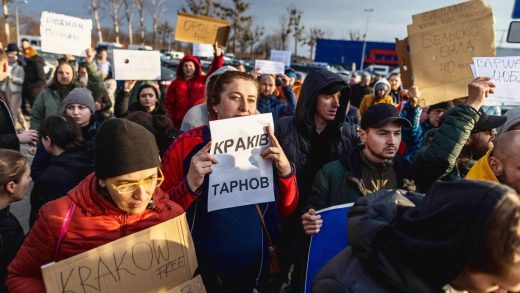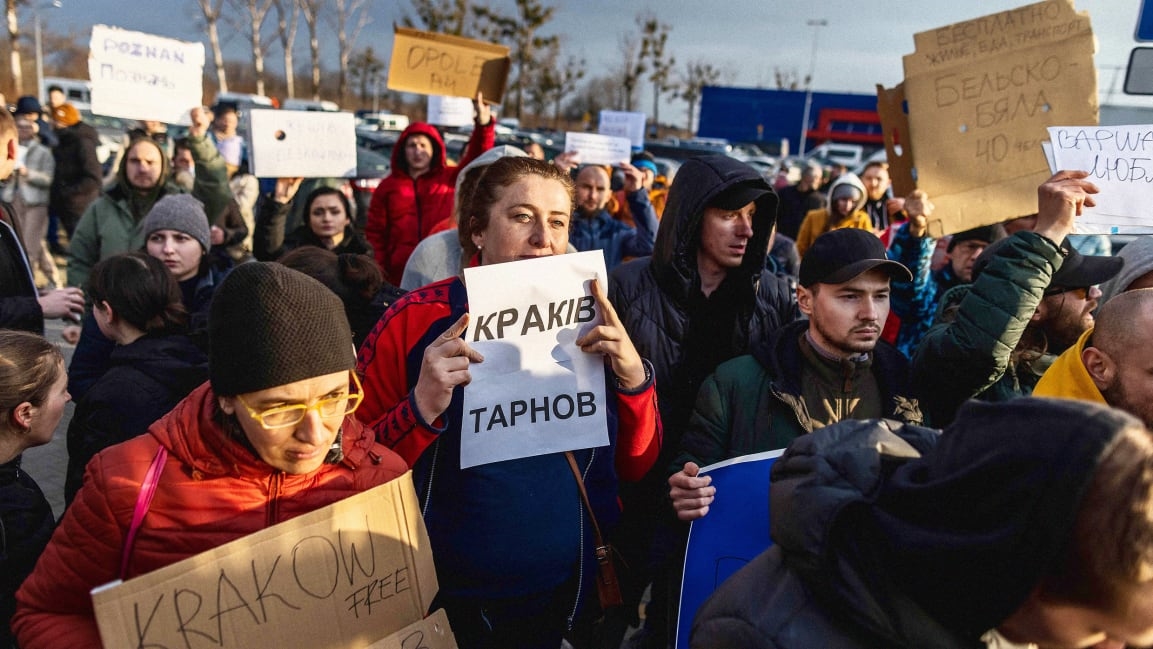A wave of grassroots humanitarianism is supporting millions of Ukrainian refugees
Along the Poland-Ukraine border, Polish volunteers have been driving Ukrainian refugees to local train stations, or directly to cities like Warsaw.
Other Poles are doing their volunteer work online or at train stations and airports, matching Ukrainian refugees with perhaps the most generous volunteers of all: those who are hosting some of the more than 2 million Ukrainians had fled their besieged country, in their own homes.
The largest refugee flow in Europe since the Yugoslav wars of the 1990s has elicited an enormous volunteer humanitarian effort in Europe, particularly in Poland, as well as in Germany, Moldova, and Romania.
A diffuse and widespread movement of millions of people that’s operating in several countries, and independently of established refugee assistance institutions, is apparently meeting many needs quite quickly.
As someone who has conducted research in southeastern Poland since 1992 and studied humanitarian work since 2014, I have long observed that digital advances are making it easier to crowdsource aid. And to assess how these arrangements are working, I’m going to conduct interviews along the Polish-Ukrainian border in March 2022, with both volunteers and professional humanitarians.
Stark contrast
What’s going on in Poland and other countries welcoming Ukrainian refugees starkly contrasts with systems that arose decades ago. Since the late 1940s, governments have largely funded aid to refugees, albeit funneling that money through independent or United Nations agencies. For example, more than two-thirds of the roughly $31 billion in humanitarian funding worldwide for refugees and disaster relief in 2021 went to UN agencies.
To be sure, these institutions are getting money to assist with Ukraine’s crisis and help the refugees who are fleeing it. Within days of Russia’s invasion, the United Nations had received more than $40 million in charitable donations from people and corporations, including $5 million from Amazon.
The UN is seeking far more money, some $1.7 billion in new funding from governments, to support Ukrainians who stayed behind and the millions more who may soon flee.
I see several disadvantages of highly concentrated and large-scale aid for refugees.
First, large-scale aid was designed to support refugee camps. Camps make the logistics of distributing aid easier. But they don’t tend to improve outcomes for the refugees, who can get stuck for years, or decades, in situations meant to be temporary. By 2018, refugee displacement was lasting on average more than 10.5 years, the World Bank estimated. Second, large-scale aid is highly standardized, which means refugees do not always get the help that meets their individual needs.
Finally, large-scale aid is often inefficient. On average, only 38 cents of each aid dollar reaches beneficiaries in the form of food, clothing, and other supplies, or cash. It isn’t possible to measure the percentage of aid that reaches refugees through grassroots aid, but it is probably much higher.
Technology eases coordination
Although thousands of people in Europe and the Middle East gave considerable amounts of grassroots aid to Syrian refugees in 2015, the Ukrainian crisis has rapidly become the first humanitarian aid operation crowdsourced at such a large scale.
Over 500,000 people have joined the Facebook group Pomoc dla Ukrainy, or Help for Ukraine, a Polish-language group whose members volunteer to give rides, housing, or bedding, or offer to help incoming Ukrainians in other ways.
Polish nonprofits, including many that had already been providing aid to Syrian refugees pushed back by the Polish government at the Belarusian border, have offered highly coordinated operations to meet incoming refugees at the Ukrainian border as well.
These groups are offering food, clothing, and help with travel to Warsaw or other cities where Ukrainian refugees can continue into Western Europe.
Two professional Polish aid groups that have helped Ukrainians in both Ukraine and Poland for years—Polska Akcja Humanitarna, which means Polish Humanitarian Action, and Fundacja Ocalenie, translated as Rescue Foundation—have led the way. Using online tools, these two organizations have been able to accept donations from around the world. They have coordinated large numbers of volunteers at the Polish-Ukrainian border, in Warsaw, and inside Ukraine, offering legal help, psychological help, and social work, along with immediate material aid.
Thousands of individual donors are also using online tools to route money to Ukrainian refugees and to organize volunteers. Some donors have sent money to Ukrainians inside Ukraine by booking rooms on Airbnb. The people booking the rooms don’t show up, but the Ukrainians listing their apartments receive the money anyway.
More flexibility
In my previous research in Germany, I have seen considerable advantages for grassroots humanitarian action versus aid, provided by either official or nongovernmental international organizations.
Most international aid agencies rely on contracts from governments, UN agencies, and other funders that require cumbersome paperwork. Managing their work in many countries at once and meeting bureaucratic obligations, such as time-consuming monitoring, evaluation, and reporting procedures, can be expensive and can require subcontracting operations. Very often, large international aid agencies take a standard approach with aid that isn’t tailored to local conditions, and therefore doesn’t meet the actual needs of refugees struggling in specific situations.
Grassroots responses are by definition not standardized. Instead, they are the result of a million individual responses to a crisis: one room to share, one person driving a car, and so on.
The people offering help are familiar with local conditions and offer the help that is immediately needed.
I have seen this approach offer lots of flexibility: Grassroots organizing can change quickly in response to changing conditions. Unlike what happens with traditional refugee-aid groups, there’s no need to clear those changes with donors, develop new project proposals, or deal with paperwork and red tape.
I have also observed that when local volunteers do the bulk of the work, aid can be distributed more efficiently. It passes directly to refugees themselves—who can also choose what help they accept.
Displaced people can then settle more quickly in cities and towns, where they may stay for months, if not years, instead of languishing in refugee camps.
Many questions
Whether this wave of grassroots humanitarianism in Poland and elsewhere in Europe can be sustained is unclear. And it’s raising many questions.
How long can Ukrainians stay in private homes, and what will they do once they cannot?
When volunteers have no oversight, what danger does this pose to refugees who are in their cars or homes?
Once the initial burst of enthusiasm passes, who will help people from Ukraine if they cannot return?
How will countries like Poland and Germany address the obvious unfairness in their treatment of Ukrainians, who are white and Christian, versus their treatment of Syrians and Afghans, who are Muslim and generally perceived in Western Europe as nonwhite?
As the number of people leaving Ukraine increases, will social or political backlash jeopardize the aid they are receiving?
Ultimately, the widespread enthusiasm for helping refugees may dissipate quickly. In that case, large aid agencies will have even more work to do. In the meantime, the rapid and generous response to Ukrainians in Poland, Germany, and other nearby countries has opened up new possibilities for grassroots humanitarian action.
Elizabeth Cullen Dunn is professor of geography and director of the Center for Refugee Studies, Indiana University.
This article is republished from The Conversation under a Creative Commons license. Read the original article.
Fast Company , Read Full Story
(31)



